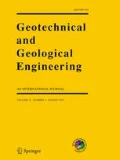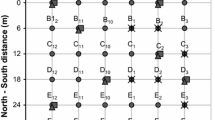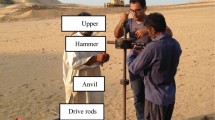Abstract
This paper presents side-by-side comparisons of blowcount values for the Texas cone penetration (TCP) test and the standard penetration test (SPT). The comparisons yielded statistically-significant regression models for both coarse-grained soils and fine-grained soils. Consistent with expected trends and published data, the TCP–SPT relationship is nonlinear, with weak to fair correlation strength (R2 = 23–44%). For TCP blowcounts (N60, TCP) varying from 25 to 200 blows/30 cm (1 ft), corresponding SPT blowcounts (N60, SPT) are typically 30–60% lower than N60, TCP in fine-grained soils. Likewise, corresponding N60, SPT blowcounts are 10–70% lower than N60, TCP in coarse-grained soils, all other things being equal. Comparative data were obtained from published sources and from project-specific field research sites used for full-scale deep foundation load tests. The final dataset consisted of 225 test pairs obtained in similar soils and geomaterials, at equivalent depths, with all blowcounts normalized to 30 cm (12 in.) penetration (i.e., blows/30 cm or blows/ft) within the bounds of typical test precision, and corrected to 60% hammer efficiency. The generally weak correlations do not support conversion of N60, TCP to N60, SPT (or vice versa) to compute foundation capacity for final design. But, engineers can certainly get an intuitive feel about site conditions and preliminary foundation capacity by using the correlation equations to translate their knowledge of one test to the other. This study extends previous work by formally comparing and contrasting the similar yet different SPT and TCP test methods in such a way as to make the results useful to users of both tests and to the broader geotechnical engineering community.

a Permission: This image appears in a TxDOT specifications document in the Public Domain. b Permission: Reproduced, with permission from “ASTM D1586-11 Standard Test Method for Standard Penetration Test (SPT) and Split-Barrel Sampling of Soils,” copyright ASTM International, 100 Barr Harbor Drive, West Conshohocken, PA 19428

a Permission: This image is from a published TxDOT research report. Permission to use image is granted by TxDOT through its copyright liaison at the Center for Transportation Research Library, Austin, TX. b Permission: This image is from a published TxDOT research report. Permission to use image is granted by TxDOT through its copyright liaison at the Center for Transportation Research Library, Austin, TX

Permission: This image is original to this paper

Permission: This image is original to this paper

Permission: This image is original to this paper

a Permission: This image is from a published TxDOT research report. Permission to use image is granted by TxDOT through its copyright liaison at the Center for Transportation Research Library, Austin, TX. b Permission: This image is from a published TxDOT research report. Permission to use image is granted by TxDOT through its copyright liaison at the Center for Transportation Research Library, Austin, TX

a Permission: Image copyright held by corresponding author, Shashank Valluru, Professional Services Industries, Inc., Houston, TX. Permission granted 12/15/2015. b Permission: Image copyright held by corresponding author, Shashank Valluru, Professional Services Industries, Inc., Houston, TX. Permission granted 12/15/2015. c Permission: Image copyright held by corresponding author, Shashank Valluru, Professional Services Industries, Inc., Houston, TX. Permission granted 12/15/2015
Similar content being viewed by others
Notes
An anecdote will illustrate this claim. During the early phase of the authors’ TCP research, a nationally-known foundation consulting firm contacted us. This firm was partnering on a multi-billion dollar, privately-funded, design-build transportation project in western Texas. Because the project was to be constructed in Texas, all bridge foundations had to meet Texas Department of Transportation (TxDOT) specifications including satisfactory design using TxDOT’s TCP-based foundation design procedure. But the principal engineers for this national firm were more familiar with the SPT, not the TCP, and they only had preliminary SPT blowcount data, not TCP blowcount data. Thus they were seeking an SPT–TCP blowcount correlation so they could do some preliminary foundation design estimates in support of their proposal. Because our research was not complete at that time, we provided the best information available—namely, the 1972 Touma–Reese correlation. Again the firm principals contacted us, asking questions about the correlation and wanting to know more details. This experience is one of the reasons why the authors think practicing engineers will find this paper helpful and the geotechnical research community will also find it interesting.
The coefficient of determination, R2 is a goodness of fit statistic that indicates how close the data are to the regression line. Further R2 is the square of the Pearson correlation coefficient, r.
References
AASHTO (2012) AASHTO LRFD Bridge Design Specifications, Customary U.S. Units, 6th edn, American Association of State Highway and Transportation Officials
ASTM D1586-11 (2011) Standard Test Method for Standard Penetration Test (SPT) and Split-Barrel Sampling of Soils. ASTM International: West Conshohocken, PA. www.astm.org
Broms BB, Flodin N (1988) History of soil penetration testing. In: International symposium on penetration testing, ISOPT 1, Orlando, March 1988. Proceedings, vol 1, pp 157–220
Burmister DM (1948) The importance and practical use of relative density in soil mechanics. In: Proceedings ASTM, vol 48, p 1249
Butler HD (1973) A study of drilled shafts constructed by the slurry displacement method. Texas Highway Department, Bridge Division, Report No. SS.25.1
Clayton CRI (1995) The standard penetration test (SPT): methods and use. Construction Industry Research and Information Association Report 143
De Mello VBF (1971) The standard penetration test: a state-of-the-art report. In: 4th Pan American conference on soil mechanics and foundation engineering, Puerto Rico, vol 1, pp 1–86
Decourt L (1989) The standard penetration test, state of the art report. In: Proceedings of the 12th international conference on soil mechanics and foundation engineering. Rio De Janeiro. August 1989, vol 4, pp 2405–2416
Duderstadt F, Coyle H, Bartoskewitz RT (1977) Correlation of the Texas cone penetrometer test n-value with soil shear strength. Texas A&M University. Texas Transportation Institute, College Station
FHWA (1998) Design and construction of driven pile foundations. Federal Highway Administration, Publication No. FHWA-HI-97-013
FHWA (2010) Drilled shafts: construction procedures and LRFD design methods. Federal Highway Administration, Publication No. FHWA-NHI-10-016
Garfield SM, Varathungarajan DA, Wright SG (2009) Improved correlation between Texas cone penetrometer blow count and undrained shear strength of soft clays. Austin, Tx: University of Texas at Austin. Center for Transportation Research (CTR)
Hamoudi M, Coyle H, Bartoskewitz RT (1974) Correlation of the Texas Highway Department cone penetrometer test with unconsolidated-undrained shear strength of cohesive soils. College Station, Tx: Texas A&M University. Texas Transportation Institute (TTI)
Hettiarachchi H, Brown T (2009) Use of SPT blow counts to estimate shear strength properties of soils: energy balance approach. J Geotech Geoenviron Eng ASCE, vol 135, no 6, June 1, 2009. ISSN 1090-0241/2009/6-830–834
Idriss IM, Boulanger RW (2012) Examination of SPT-based liquefaction triggering correlations. Earthq Spectra EERI 28(3):989–1018
Jefferies MG, Davies MP (1993) Use of CPTU to estimate equivalent SPT N60. Geotech Test J ASTM, 16(4):458–468 https://doi.org/10.1520/GTJ10286J. ISSN 0149-6115
Kasim AG, Chu M-Y, Jensen CN (1986) Field correlation of cone and standard penetration tests. J Geotech Eng ASCE 112(3):368–372
Kovacs WD, Salomone LA (1982) SPT hammer energy measurement. J Geotech Eng Div ASCE 108(GT4):599–620
Lacroix Y, Horn H (1973) Direct determination and indirect evaluation of relative density and its use on earthwork construction projects. In: Evaluation of relative density and its role in geotechnical projects involving cohesionless soils. ASTM Special Technical Publication, vol 523, pp 251–280
Lawson WD, Mikulec CM, McClelland MP, Irby EF Jr., Jayawickrama PW, Levi L (2009) Assessment of rock strength by texas cone penetrometer and uniaxial compression tests. In: Contemporary topics in in situ testing, analysis, and reliability of foundations. ASCE: GeoFlorida 2009. https://doi.org/10.1061/41022(336)11
Loehr JE, Bowders JJ, Ge L, Likos WJ, Luna R, Maerz N, Rosenblad BL, Stephenson RW (2011) Engineering policy guidelines for design of drilled shafts. Report cmr12003. University of Missouri: Columbia, MO
Massarsch KR (2014) Cone penetration testing—a historic perspective. In: Robertson PK, Cabal KL (eds) Proceedings of 3rd international symposium of cone penetration testing, CPT14, 13–14 May, 2014, Las Vegas, Nevada, USA. ISBN: 978-0-615-98835-1, Paper# KN-4, pp 97–134
Mayne P, Kemper J (1988) Profiling OCR in stiff clays by CPT and SPT. Geotech Test J ASTM 11(2):139–147, https://doi.org/10.1520/GTJ10960J. ISSN 0149-6115
Minitab (2014) Minitab 17. Statistical Analysis Software. www.minitab.com
Moghaddam RB, Lawson WD, Surles JG, Seo H, Jayawickrama PW (2017) Hammer efficiency and correction factors for the TxDOT texas cone penetration test. Geotech Geol Eng. https://doi.org/10.1007/s10706-017-0234-8
Nam MS (2004) Improved design for drilled shafts in rocks Ph.D. Thesis. Houston, Tx: University of Houston
Nixon IK (1982) Standard penetration test, state-of-the-art report. In: Proceedings, European symposium on penetration testing, ESOPT-2. Stockholm, AA Balkema Publishers: The Netherlands, vol 1, pp 3–24
O’Neill MW, Reese LC (1970) Behavior of axially loaded shafts in Beaumont Clay. Texas Highway Department, Center for Highway Research, Report No. 89-8-2 Austin, Tx: University of Texas at Austin. Center for Transportation Research (CTR)
Paikowsky SG, Whitman RV, Baligh MM (1989) A new look at the phenomenon of offshore pile plugging. Mar Geotechnol 8(3):213–230
Pile Dynamics, Inc. (2009) SPT analyzer specifications. Quality assurance for deep foundations. Pile Dynamics, Inc.: Cleveland Ohio. June 2009. http://www.pile.com/Specifications/PDIProducts/PDISPTSpecs.pdf. Accessed 23 Aug 2014
Reese LC, Hudson WR (1968) Field testing of drilled shafts to develop design methods. Texas Highway Department, Center for Highway Research, Report No. 89-1 University of Texas at Austin. Center for Transportation Research (CTR)
Rogers DJ (2006) Subsurface exploration using the standard penetration test and the cone penetrometer test. Environ Eng Geosci XII(2):161–168
Schmertmann JH (1978) Use the SPT to measure dynamic soil properties?—Yes, but …!”. Dyn. Geotech. Test. ASTM STP, vol 654, pp 341–355
Schmertmann JH, Palacios A (1979) Energy dynamics of SPT. J Geotech Eng Div ASCE 105(8):909–926
Schnaid F (2009) In situ testing in geomechanics: the main tests. Taylor & Francis: New York. ISBN: 0-203-93133-5
Seo H, Moghaddam RB, Surles JG, Jayawickrama PW, Wood TA, Lawson WD (2015) Reliability based deep foundation design using Texas cone penetrometer (tcp) test: Volume 1, Development of Load Test Dataset. Report FHWA/TX-14-0-6788-1-Vol. 1. Texas Tech University Center for Multidisciplinary Research in Transportation: Lubbock, TX. December 2015
Seo H, Moghaddam RB, Surles JG, Jayawickrama PW, Wood TA, Lawson WD (2015) Reliability based deep foundation design using texas cone penetrometer (TCP) test: volume 2, resistance factors for driven pile foundations. Report FHWA/TX-14-0-6788-1-Vol. 2. Texas Tech University Center for Multidisciplinary Research in Transportation: Lubbock, TX. December 2015
Seo H, Moghaddam RB, Surles JG, Jayawickrama PW, Wood TA, Lawson WD (2015) Reliability based deep foundation design using texas cone penetrometer (TCP) test: volume 3, resistance factors for drilled shaft foundations in soil. Report FHWA/TX-14-0-6788-1-Vol. 3. Texas Tech University Center for Multidisciplinary Research in Transportation: Lubbock, TX. December 2015
Skempton AW (1986) Standard penetration test procedures and the effects in sands of overburden pressure, relative density, particle size, ageing and over-consolidation. Geotechnique 36(3):425–447
Minitab 17 Support (2016) Basic statistics and graphs. Minitab 17 Support. http://support.minitab.com/en-us/minitab/17/
Touma FT, Reese LC (1972) The behavior of axially loaded drilled shafts in sand. Report No. CFHR 3-5-72-176-1. Center for Highway Research, The University of Texas at Austin, Austin, TX
Transportation Research Board (2014) Load and resistance factor design (LRFD) site specific variability in laboratory and field measurements and correlations. Research in Progress No. 01543062. Sponsor: Arkansas State Highway and Transportation Department. Performing Organization: University of Arkansas, Fayetteville
TxDOT (1999) Test procedure for texas cone penetration. Test Designation Tex-132-E. Technical Material Specifications, E-Series: Texas Department of Transportation, Austin, TX
TxDOT (2012) Geotechnical manual. Texas Department of Transportation, Bridge Division, Austin
Ulugergerli E, Uyanik O (2007) Statistical correlations between seismic wave velocities and SPT blow counts and the relative density of soils J Test Eval ASTM 35(2):187–191 https://doi.org/10.1520/JTE100159. ISSN 0090-3973
Valluru S, Vennalaganty KM, Endly SN, Goin W (2007) Soil characterization of state highway 130 (SH130) alignment. In: Proceedings of the Texas Section ASCE, Fall 2007. ASCE: Austin, TX
Varathungarajan DA, Garfield SM, Wright SG (2009) Characterization of undrained shear strength profiles for soft clays at siz sites in Texas. Austin, Tx: University of Texas at Austin. Center for Transportation Research (CTR)
Vijayvergiya VN, Hudson WR, Reese LC (1969) Load distribution for a drilled shaft in clay shale. Austin, Tx: University of Texas at Austin. Center for Transportation Research (CTR)
Vipulanandan C, Puppala AJ, Jao M, Kim MS, Vasudevan H, Kumar P, Mo YL (2008) Correlation of Texas cone penetrometer test values and shear strength of Texas soils. Universisty of Houston, Houston
Youd TL, Bartholomew HW, Steidl JH (2008) SPT hammer energy ratio versus drop height. J Geotech Geoenviron Eng ASCE, vol 134, no. 3, March 1, 2008. ISSN 1090-0241/2008/3-397–400
Acknowledgements
The authors thank the Texas Department of Transportation (TxDOT) for their sponsorship of Project No. 0-6788, the TCP Reliability research study. The authors also thank the many engineers and researchers who provided data associated with this study.
Author information
Authors and Affiliations
Corresponding author
Ethics declarations
Conflict of interest
The authors declare that they have no conflict of interest.
Rights and permissions
About this article
Cite this article
Lawson, W.D., Terrell, E.O., Surles, J.G. et al. Side-by-Side Correlation of Texas Cone Penetration and Standard Penetration Test Blowcount Values. Geotech Geol Eng 36, 2769–2787 (2018). https://doi.org/10.1007/s10706-018-0499-6
Received:
Accepted:
Published:
Issue Date:
DOI: https://doi.org/10.1007/s10706-018-0499-6




